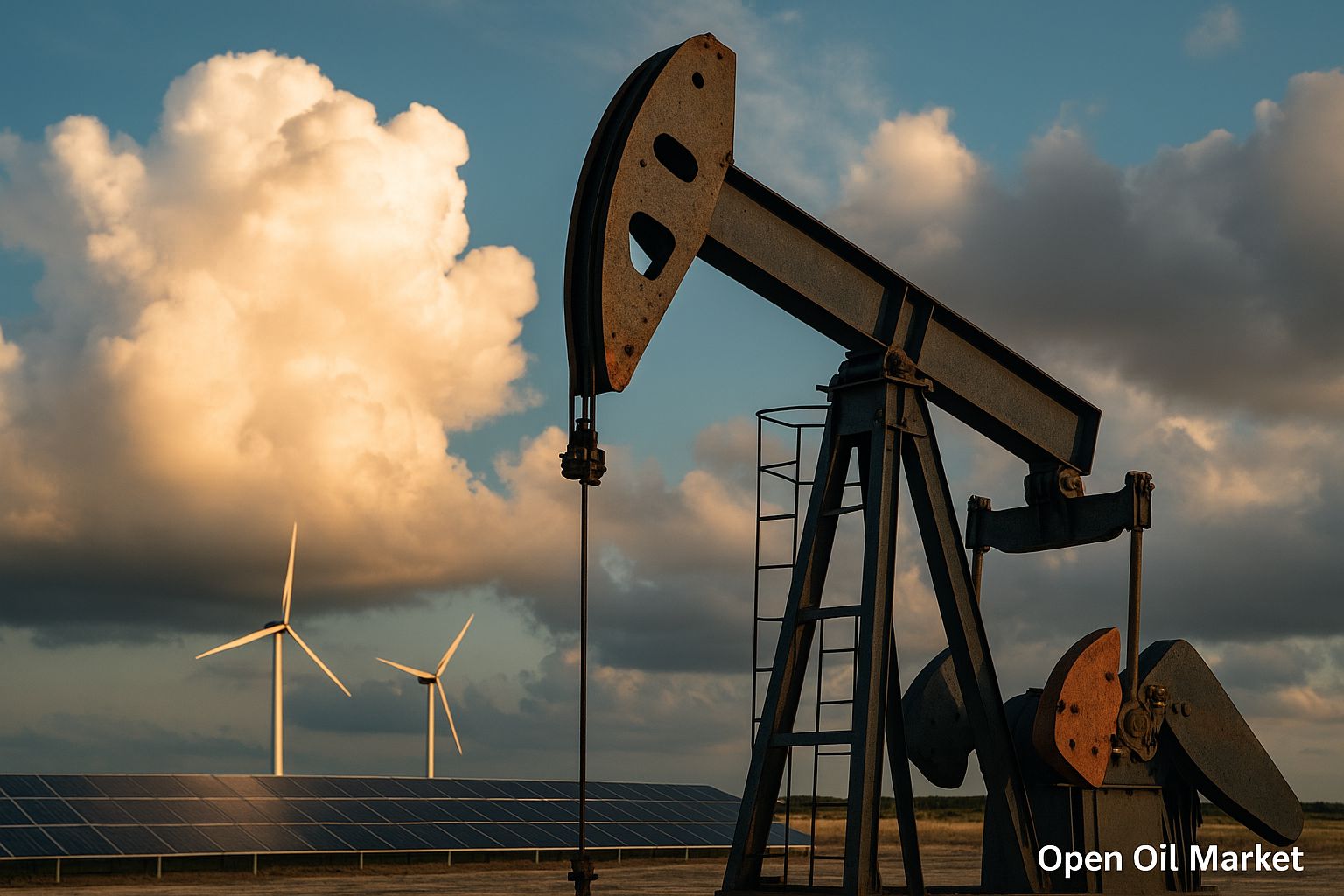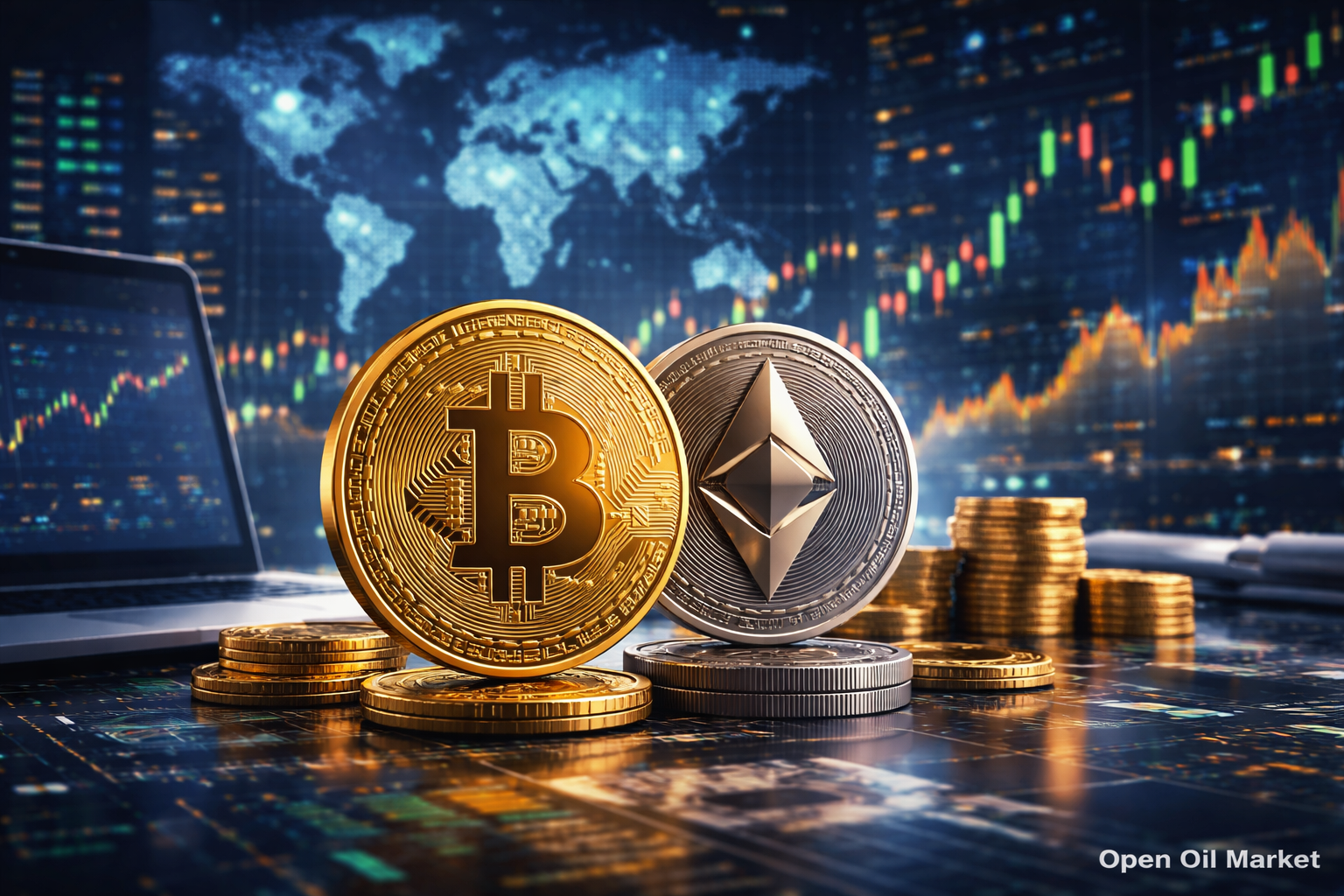
Current News on the Fuel and Energy Complex as of October 13, 2025: Stabilization of Fuel Market in Russia, Sanction Pressures on Oil and Gas, Record Investments in Renewable Energy, and Preparation for Russian Energy Week. Analysis by Open Oil Market.
The first half of October is characterized by ongoing efforts to normalize the internal fuel market in Russia in the wake of a recent crisis, alongside noticeable shifts in global commodity markets. Oil prices remain under pressure due to expectations of oversupply, while Western sanctions against the Russian oil and gas sector are tightening, affecting trade flows. The European gas market enters winter with record reserves, supporting stability, while the industry prepares for a key event – Russian Energy Week in Moscow. Below is an overview of current events in the fuel and energy sector that are significant for investors, market participants, and oil and gas companies.
Stabilization of the Fuel Market in Russia: Government Measures and Initial Results
Following a peak gasoline shortage in September, the situation in the internal fuel market has started to gradually stabilize. In several regions, the strictest restrictions on fuel supply have been lifted, and independent gas stations are partially resuming full operations. Wholesale prices for petroleum products, which had previously reached historical highs, have adjusted downward thanks to emergency measures taken by the Russian government. However, in remote areas away from major oil refineries (the Far East and certain regions of Siberia), relative supply tension persists, and authorities continue to keep the situation under control.
- Emergency Measures and Imports: The government has extended the ban on the export of automotive gasoline until the end of 2025, while restrictions on the export of diesel fuel for independent traders remain in effect. These steps are aimed at redirecting the maximum amount of petroleum products to the internal market. At the same time, measures to attract fuel from abroad are being considered: for instance, discussions are underway regarding the elimination of import duties to facilitate the import of gasoline and diesel from neighboring countries (such as from Belarusian refineries) to cover shortages in remote regions.
- Price Control and Dampening Mechanism: As of October 1, a moratorium on the elimination of the fuel dampening mechanism was imposed – the government temporarily canceled the price deviation threshold, beyond which payments to refiners would cease. This move means that oil companies will continue to receive compensation for supplies to the domestic market, even if wholesale prices exceed indicative levels. The dampening mechanism in its updated form is expected to restore the economic incentive to supply gasoline and diesel to gas stations domestically. Concurrently, the Federal Antimonopoly Service (FAS) and the Ministry of Energy have intensified price monitoring: warnings have been issued to several gas stations for unjustified price hikes, with violators facing fines and orders to reduce prices at the pumps.
- Initial Outcomes: As unscheduled repairs at oil refineries conclude and export volumes are redirected to the domestic market, the deficit in motor fuel is gradually decreasing. In Central Russia and several other affected regions, wholesale shipments began to increase at the beginning of October, allowing for replenishment of gas station reserves. The government expects that the combination of measures taken will enable the country to enter the winter season without acute supply disruptions, though the situation still requires constant monitoring.
Oil Market: OPEC+ Decision, Supply Pressure, and Sanction Risks
The global oil market at the beginning of October demonstrates a relative price calm, transitioning into a declining phase after recent peaks. Following the OPEC+ meeting on October 5, it was announced that the alliance confirmed its plan for a moderate increase in production of about +137,000 barrels per day starting in November. This continuation of a cautious easing of quotas aims at gradually restoring market share without collapsing prices. In response to this decision, Brent prices remain stable at around $63–65 per barrel, significantly lower than the year's peaks (around $80). American oil WTI has fallen into the $58–60 range. Investors are expressing caution as expectations for oversupply in the fourth quarter of 2025 are rising, applying pressure on prices.
- Limited Production Growth: Although OPEC+ has officially raised the overall quota, the actual increase in supply will be constrained. Many member countries are close to their maximum production capacities; therefore, even the allowed increase of ~0.14 million barrels/day will only minimally expand actual output. Nonetheless, the cartel’s coordinated actions signal to the market the intent to maintain balance: it is expected that in the absence of shocks, Brent will remain within the $60–70 per barrel range in the coming weeks.
- Oversupply and Demand: Analysts warn of a high likelihood of oil surplus on the global market by the end of the year. Economic growth in China and Europe is slowing, while production in non-OPEC countries (primarily the U.S.) is increasing at a rapid pace. The EIA forecasts that the average price of Brent in 2025 will be around $68 per barrel – 10–15% lower than the previous year. The market is factoring in these expectations: current oil prices are about 20% lower than the spring peaks. If supply forecasts are realized, price pressure could persist until 2026.
- Sanctions and Geopolitics: Heightened sanction pressures create additional risks for the oil market. Following the mid-year introduction of the 18th EU sanctions package, which includes a reduction in the price cap on Russian oil to $47.6 per barrel, Western countries are discussing new restrictions. Washington is urging allies to achieve a complete abandonment of Russian energy supplies and to more strictly enforce sanctions evasion (e.g., through a "shadow fleet" of tankers). Any tightening of sanctions could reduce the available global supply, potentially reversing the price trend unexpectedly. Additionally, areas of instability persist: conflicts in the Middle East and Eastern Europe threaten disruptions in oil production or exports. Despite current price weakness, the geopolitical risk factor remains on the agenda and may manifest itself in the event of escalation.
- Russian Exports and New Markets: So far, sanctions have not led to a sharp decline in oil exports from Russia. Russian oil companies have successfully redirected their primary volumes to Asia. India and China remain the largest buyers: traders estimate that about one-third of India's oil needs are currently met with Russian crude. Moreover, there is a growing flow of Russian supplies to Turkey, the Middle East, and Africa. Such sales geography supports the revenues of Russian oil companies and partly mitigates the balance of supply and demand in the global market. However, if further sanctions strengthen (such as the introduction of secondary restrictions or tariffs), this sales channel could narrow, posing a challenge for the Russian oil and gas sector.
Natural Gas: Comfortable Reserves in Europe and Reorientation of Russian Flows
The global gas market is presenting a favorable situation ahead of winter. The European Union enters the heating season with record reserves: underground gas storage facilities (UGS) in EU countries are filled to over 95% of their maximum capacity. This is significantly higher than last year's level and provides a safety cushion in case of cold weather. Wholesale gas prices in Europe remain relatively low – the TTF index fluctuates between €30–35/MWh, which is several times lower than the peaks of autumn 2022. The combination of high reserves and restrained demand keeps the market stable.
- Full Storage and LNG: Mild weather and energy-saving efforts over the summer have allowed European countries to reach nearly maximum UGS levels without emergency purchases. Significant volumes of liquefied natural gas (LNG) have played a vital role: due to relatively weak gas demand in Asia, substantial amounts of LNG have been redirected to Europe. This has compensated for the decrease in pipeline supplies from Russia. Consequently, European energy security appears more robust than it has in recent years before winter. Even in the event of cold weather, Europe has sufficient reserves to avoid extreme price spikes in the coming months.
- Complete Abandonment of Russian Gas: EU countries continue the course to reduce dependence on Russian gas. Direct pipeline supplies from Russia have fallen to minimal volumes and are only sustained in certain countries (such as Hungary) through long-term contracts. Concurrently, the European Commission is preparing the 19th sanctions package, which proposes legally enshrining a phased withdrawal from Russian LNG for the first time. It is planned to completely cease the purchase of Russian gas in any form by 2026–2027. This political decision is already being practically implemented by the market: the share of gas from Russia in EU imports has dropped from ~40% to less than 15% in two years. Remaining purchases (including LNG in France, Belgium, and Spain) are under public pressure and are likely to be reduced to zero in the coming years. A complete embargo on Russian gas would, on one hand, deprive Gazprom of a key market, while, on the other hand, incentivize Europe to rapidly develop alternative sources and infrastructure (new LNG terminals, pipelines from Africa, etc.).
- Russia's Asian Pivot: In response to the loss of the European market, Russia is shifting its gas exports eastward. Supplies through the Power of Siberia pipeline to China continue to grow and are expected to reach record levels in 2025 (expected to exceed 22 billion cubic meters per year). Simultaneously, Moscow is negotiating the construction of a second main gas pipeline to China via Mongolia (Power of Siberia 2), which could partially compensate for the lost European market by the end of the decade. There are also discussions about expanding cooperation with Turkey: the "gas hub" model in Turkey implies that part of the Russian gas could be sold to Europe as Turkish gas, formally bypassing sanctions. However, these projects require time and investment. In the short term, gas exports from Russia will remain below pre-pandemic levels, with a primary focus on maintaining stable supply for domestic consumers and CIS partners. For instance, Russia and Belarus have recently extended their agreement on gas supplies on preferential terms for five years, providing price predictability for allies.
Electric Power: Record Consumption and Infrastructure Modernization
Global electricity consumption continues to set new records in 2025. Economic growth and technological changes are driving increased demand for electricity across all sectors. It is forecasted that the total electricity generation volume worldwide will exceed 30,000 TWh for the year – a historic maximum. Major contributions are expected from leading economies: in the U.S., about 4.1 trillion kWh of consumption is anticipated (a new absolute record), while in China, over 8.5 trillion kWh. In developing countries in Asia, the Middle East, and Africa, energy consumption is also rapidly increasing due to industrialization and population growth. Such demand size opens new opportunities for energy companies while presenting complex challenges for energy systems.
- Network Load: The unprecedented growth in electricity demand requires expedited modernization of infrastructure. Many countries have announced large-scale investment programs to expand and upgrade electrical networks, as well as to construct additional generating capacities. The goal is to avoid power shortages and prevent supply disruptions during peak loads. For example, several U.S. states are investing billions of dollars to enhance networks due to booming demand from data centers and electric vehicle charging stations. In China, a national "smart grid" plan is being implemented to integrate the growing volume of renewable generation and ensure reliable transmission over long distances. In Russia and CIS countries, consumption growth is more moderate (about +2–3% per year), but geopolitical factors dictate the need for reserves: electricity exports from Russia have decreased, and domestic generation and networks are adapting to new conditions. The Russian government is focusing on improving the reliability of power supply to remote regions and modernizing facilities within the Unified Energy System.
- Energy Efficiency: One of the key ways to balance supply and demand is through energy efficiency improvements. In the context of high energy prices and climate agendas, many countries are implementing programs to reduce losses and transition to more efficient equipment. From industry to housing and communal services – modern technologies (LED lighting, energy-efficient motors, "smart homes") are being adopted to curb consumption growth without compromising economic development. Such measures are particularly relevant for the EU, where record-high demand for electricity is accompanied by a course on decarbonization – efficient energy use helps avoid network overload and reduce CO₂ emissions.
Renewable Energy: Record Investments and Increasing Share of RE
The renewable energy (RE) sector in 2025 continues to show impressive growth, affirming the global trend toward the "green" transformation of the fuel and energy complex. Investments in solar, wind, and other clean technologies are hitting historical records: just in the first six months of 2025, around $400 billion was invested globally in RE projects – 10–12% more than in the same period last year. Capital is primarily directed towards the construction of new solar and wind power plants, as well as the development of energy storage infrastructure (industrial batteries) and the modernization of networks to integrate distributed generation. Thanks to these investments, new capacities are being brought online, allowing for increased electricity generation without a rise in greenhouse gas emissions.
Statistics confirm high growth rates: industry estimates suggest that in the first half of 2025, approximately 380 GW of new solar power plants were installed globally – nearly 1.7 times more than the previous year. Significant contributions came from megaprojects in China, India, the Middle East, and the U.S. Wind energy is also witnessing a surge: large offshore wind farms have come online off the coasts of the UK, China, Vietnam, and other countries, adding dozens of gigawatts of capacity. These achievements have led the total share of RE in global electricity production to reach a new high.
- Growing Share of Clean Energy: Renewable sources are gradually occupying an increasingly significant portion of the energy balance. On average globally, RE currently accounts for around 30% of electricity generation. In the European Union, this figure exceeds 45% due to active "green transition" policies and accelerated phase-out of coal plants. China is nearing the 30% generation mark from RE, despite the massive scale of its energy system and ongoing construction of new coal-fired power plants. According to analysts, in the first half of 2025, electricity generation from solar and wind for the first time surpassed that from coal – a significant event for global energy.
- Government Support for the Sector: Governments of leading economies are intensifying incentives for the development of renewable energy. New climate targets have come into effect in the EU, requiring accelerated commissioning of clean capacities and expansion of green certificate trading. In the U.S., the implementation of subsidy and tax incentive programs for equipment manufacturers and investors in RE continues (as part of the Inflation Reduction Act, IRA). CIS countries are also not lagging behind: in Russia and Kazakhstan, new competitive selections for RES projects are being announced, while Uzbekistan is implementing ambitious plans for building solar parks in desert regions. State support is intended to ensure further investment inflow and reduce industry costs, making "green" energy attractive for businesses.
- Challenges: The rapid growth of RE is accompanied by challenges. High demand for equipment and materials (e.g., polycrystalline silicon for solar panels) is creating tension in supply chains and leading to project cost increases. The industry faces a shortage of skilled labor for constructing and operating hundreds of new facilities. Additionally, energy systems require flexibility: integrating significant volumes of intermittent generation (solar and wind) necessitates the development of energy storage systems and intelligent load management. Despite these difficulties, the global course on decarbonization remains unchanged – experts predict that investment in RE will continue to grow in the coming years, and the share of clean energy in the balance will keep setting new records.
Coal: Asian Demand vs. Coal Phase-Out Policies
The global coal market in 2025 shows mixed dynamics. On the one hand, demand for coal in several regions has temporarily increased. During the summer, there was a surge in thermal coal imports by East Asian countries: for instance, in August, purchases by China, Japan, and South Korea rose by almost 20% compared to the previous month. The reason for this was internal factors: in China, due to heightened safety and environmental inspections, coal production temporarily decreased, while industrial electricity demand rapidly recovered. The shortfall in generation in China was compensated through additional coal imports, pushing regional prices upwards: prices for Australian Newcastle coal exceeded $110 per ton (the highest in the last 5 months). Similarly, India and several other Asian countries increased coal consumption to stabilize their energy systems.
On the other hand, long-term trends remain unfavorable for the coal industry. Many countries continue their policy of gradually phasing out coal for environmental purposes and in the fight against climate change. In the European Union, the share of coal generation in electricity production has already fallen below 10% (compared to about 15% a few years ago). Eleven EU countries have officially announced plans to shut down all coal-fired power plants by 2030, replacing them with gas and renewable capacities. In the U.S., while federal initiatives to support the coal industry (such as subsidies for mine modernization and extending the operation of certain power plants for energy security reasons) have been voiced, market conditions remain challenging: cheap natural gas and growth in RE make coal less competitive. Even in traditionally "coal-heavy" economies, coal utilization is declining: Germany, which temporarily increased coal burning in 2022-2023 due to the gas crisis, has once again reduced coal-fired generation in 2025.
- Reconstruction of Export Flows: For Russia, one of the world's largest coal exporters, changes in the global market signify a reorientation of supplies. Following the EU's embargo on Russian coal (since mid-2022), domestic coal companies have shifted the majority of their volumes to Asia. Currently, over 75% of Russia's coal exports are directed to China, India, Turkey, and other Asia-Pacific countries. This demand partially offsets the loss of the European market, although the profit margins from sales are lower due to logistics costs and discounts for Asian buyers. Looking ahead, as the largest economies shift away from coal, Russian coal producers will need to adapt – developing deep processing methods, seeking new niches (such as metallurgical coal), or cutting production at less profitable mines.
- Climate Obligations: The global energy shift places pressure on the coal industry. More countries are joining initiatives to reduce emissions: carbon taxes are being introduced, cross-border regulatory mechanisms (CBAM in the EU) are being established, and financial institutions are limiting funding for coal projects. These factors are already leading to a significant reduction in investments in new coal capacity outside of developing countries. To meet the goals of the Paris Agreement, experts from the International Energy Agency recommend that the peak global coal consumption has already been surpassed and anticipate sustained demand declines in the coming decades. In such an environment, government support programs for the coal industry (such as in the U.S. or China) tend to be temporary and face criticism from environmentalists.
Forecasts and Expectations: Focus on the Energy Forum and Winter Season
The start of Q4 2025 brings mixed expectations among fuel and energy market participants. On one hand, the stabilization efforts provide hope for gradual improvement – particularly in the internal fuel market in Russia, where the impact of government measures is already starting to be felt. On the other hand, there remain many uncertainties ahead.
- Russian Energy Week: In Moscow, from October 15–17, the forum "Russian Energy Week 2025" will take place, serving as a central platform for discussing the development strategy for the fuel and energy complex. Key officials from the country and leading energy companies are expected to address the adaptation of the sector to sanction conditions, promotion of exports to friendly nations, and development of new projects (LNG, petrochemicals, RE). Investors and analysts will closely monitor statements made during the forum, as these are expected to set the tone for the market in the coming months and clarify the directions of government policy in the context of external pressures.
- Winter Factor: The heating season in the Northern Hemisphere is ahead. A mild winter could solidify the current stability in gas and electricity markets: under moderate temperatures, high gas reserves in Europe and accumulated fuel reserves would ensure a smooth winter without price shocks. However, extremely cold weather could once again create stress for energy systems – increasing demand for gas, electricity, and coal, which could lead to price spikes even with full storage. The markets are factoring in these risks into their forecasts: price volatility for energy carriers may temporarily increase in the event of weather anomalies.
- Monetary and Economic Conditions: The global financial situation also impacts the fuel and energy complex. Rising interest rates and signs of economic slowdown in several countries may reduce investment activity in the sector. For oil and gas companies, the cost of borrowing capital is a critical issue – complications in financing could reflect on plans for new field development and refinery modernization. Additionally, the pace of industrial production will determine demand dynamics for raw materials: if the global economy enters stagnation, oil and gas prices could remain under pressure. However, any stimulating measures (e.g., new infrastructure investment programs in China or easing of the Fed’s policy in the U.S.) will support energy demand and could help balance the market.
Overall, participants in the fuel and energy sector are completing 2025 in a mode of adaptation to new realities. The sanction standoff between Russia and the West continues to reshape trading flows for oil, gas, and coal. Businesses are seeking to hedge risks and explore new niches – whether it is redirecting exports to Asia, implementing digital trading platforms, or developing deep processing of raw materials domestically. Simultaneously, the energy transition is gaining momentum: record investments in RE and energy conservation will determine the long-term configuration of the sector. The coming months will reveal how successfully the winter challenges will be navigated and how to ensure a balance of interests – from fuel companies to end consumers – against the backdrop of such a complicated 2025.




